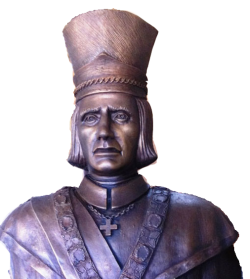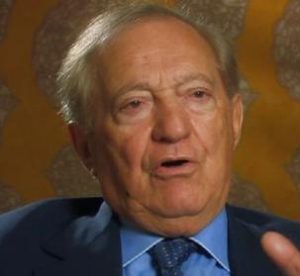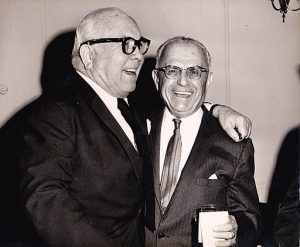9 Greeks
1. Greeks Before the Great Migration

1 Greek mass immigration into the United States was a predominantly 20th-century affair; however, as was the case for Italians, isolated instances can be found of Greeks having arrived in North America centuries earlier. For instance, as early as 1528, a Greek by the name of Doroteo Teodoro landed in Florida. Known by the Spanish as Theodoros Griego or Theodore Greek, Teodoro accompanied explorer Cabeza de Vaca’s group on their adventures in North America during the early 16th century, as evidenced by the fact that de Vaca mentions Teodoro in his book Relacion, first published in 1542. Another famous 16th-century Greek adventurer was Juan de Fuca. As with Doroteo Teodoro, de Fuca’s Spanish sounding name obscures the fact that he was actually a Greek, named Ioannis Fokas (or Phokas). A navigator in the service of Philip II of Spain, Fokas is best known for his exploration, in 1592, of the passage now known as the Strait of Juan de Fuca that runs between Vancouver Island, Canada and the Olympic Peninsula of Washington State.[1]

2 In 1768, with Florida under British control, Greeks established a short-lived colony at New Smyrna Beach, and when it failed, many of the inhabitants moved to neighboring Saint Augustine. A stable Greek community also sprang up in New Orleans in 1866. A number of Greeks are also known to have participated in both the American Revolutionary War and the American Civil War.[2]
3 However, immigration from Greece did not begin in earnest until about 1890, and the numbers were small compared to countries like neighboring Italy. According to Immigration and Naturalization Service data, for example, “approximately 421,000 Greeks immigrated to the United States between 1890 and 1921.”[3] By comparison, as previously noted, more than 4.1 million Italians entered the United States from 1880–1920.
2. Greek Pride
1 As Daniels has noted: “Greeks who immigrated to the United States generally had a fierce sense of their own Greekness,” partly because of their awareness of the past glories of Greek civilization, but also because for centuries Greece had chafed under the Ottomans, a powerful state that originated in what is today Turkey and that once controlled much of southeastern Europe, Asia Minor, and North Africa. The Ottoman domination of Greece evoked in Greeks a fervent nationalism and a desire for self-determination, which in 1821 erupted in the Greek War of Independence and led to the establishment of an independent modern Greek state.[4]
Traits such as “Greek pride” have been humorously caricatured in popular cinema, a notable example being the 2002 romantic comedy, My Big Fat Greek Wedding, (see clip below) in which Gus Portokalos, the patriarch of a Greek American family, repeatedly offers evidence to prove that “everything comes from the Greek.”
3. Features of Greek Migration
1 In some respects, the characteristics of the first Greek immigrants mirrored that of many other groups comprising the “new immigration.” For instance, the earliest arrivals were predominantly male (~ 88%). However, Greek immigration exhibited a number of characteristics that distinguished it from that of other groups. For one thing, “Greeks were among the last of the Europeans to immigrate to America”[5] during the era immediately preceding World War I, after which U.S. immigration restrictions substantially reduced the ability southern and eastern Europeans to immigrate until 1965. In addition, Greeks “were the only fairly large European group of which more than half [~ 54%] returned” to the home country (although they were somewhat similar to the Italians in this regard).[6]
2 Like many other groups from southern and eastern Europe, Greeks initially faced considerable racial prejudice and were excluded from certain types of work, as well as from use of public establishments. Greek workers, however, did not let discriminatory treatment prevent them from participating in labor and political movements directed towards securing social justice for all immigrants.[7]
4. Settlement Patterns and Livelihoods
1 The majority of Greeks “settled on the East Coast, primarily in Florida and New York, and [in] the industrial Midwest, in Chicago, Detroit, and Pittsburg” although some settled in smaller numbers on the West Coast where they found work in construction, lumbering, and mining.[8] Although Greek settlers in the West began as laborers, many of them soon moved into the middle classes by becoming store owners, establishing restaurants, bars, candy stores, confectioneries, hotels and other businesses. Eventually, women arrived from the old country making a normal family life possible.[9]
2 Greeks that went to New England mill towns often worked in the textile and shoe factories. By the 1920s, Lowell, Massachusetts boasted the third largest Greek community in America after New York and Chicago. Indeed, the first Byzantine-style Greek Orthodox Church in America, “Holy Trinity,” was built in 1906 in Lowell. Out of a total population of 100,000, the Greek population of Lowell numbered 20,000 in 1910. On the other hand, Greeks who went to large Northern cities, such as New York and Chicago, worked in factories, or as busboys, dishwashers, bootblacks, and peddlers. By 1914, there were also Greek communities across the Northeast and Midwest, from Philadelphia, Pittsburg, and Buffalo to Cleveland, Toledo, Detroit, and Milwaukee.[10]
3 Although Greek immigrants often began as humble laborers, many Greeks seemed to possess an enterprising spirit, enabling them to distinguish themselves as successful entrepreneurs. Indeed, the achievements of some prominent Greek Americans have sometimes led to a perception of Greek exceptionalism in the realm of business, particularly in sectors such as the restaurant and food industries, real estate, and shipping. Examples of notable Greek American entrepreneurs, include individuals like George Behrakis, George Argyros, and John Catsimatidis.

4 George Behrakis, who earned a pharmacy degree from Northeastern University in 1957, went on to found Muro Pharmaceuticals in 1971, a company specializing in the development and marketing of respiratory drugs, particularly medications for the treatment of asthma and chronic obstructive pulmonary disease (COPD). Behrakis is also well-known for his philanthropy. He has generously supported various educational, cultural, and healthcare initiatives both in the United States and Greece. Behrakis’ contributions have had a transformative impact on organizations such as Tufts University, the Museum of Science in Boston, and the National Hellenic Museum in Chicago. Behrakis’ dedication to philanthropy and entrepreneurship has earned him numerous accolades and honors, including honorary doctorates from several institutions and induction into the National Hellenic Museum Hall of Fame.

5 A real estate entrepreneur educated at Chapman University, George Argyros co-founded Arnel & Affiliates, leaving a lasting mark in various business ventures. Argyros’ commitment to education is evident through a $5 million gift to his alma mater. Serving as the U.S. Ambassador to Spain, he facilitated diplomatic ties. His diverse legacy includes ownership of the Seattle Mariners, showcasing a multifaceted approach to entrepreneurship in real estate, sports, and international diplomacy.

6 With a background that includes studies at New York University, John Catsimatidis, CEO of the Red Apple Group, is a notable figure in the energy and supermarket industries. His entrepreneurial ventures include owning Gristedes supermarkets and the United Refining Company. Catsimatidis’ significant impact on New York’s economic landscape, employing thousands and investing in real estate projects like the redevelopment of the Atlantic City Boardwalk, is complemented by his educational foundation and strategic business acumen.

7 One enterprise in which some Greeks played a pioneering role was the motion picture industry. The first movie houses were small operations set up in stores merely as a cheap amusement for the working public. A few benches, a screen, and a projector were the only equipment. But eventually, of course, the motion picture industry became a huge enterprise, dominated mostly by Jewish immigrants, but also engaging a significant number of Greeks, such as Spyros Skouras and his brothers, Charles and George, who controlled the 20th Century Fox studios.[11]
5. Second Wave
1 After the first major wave of Greek immigration in the late 19th and early 20th century, further Greek immigration remained on hold from the passage of the Immigration Act of 1924 until the end of World War II (1945). It resumed only after the U.S. relaxed its restrictive immigration policies to admit persons displaced by the war, at which time about one hundred thousand Greeks arrived over the next twenty years. Then in the 1960s, “immigration laws were changed to allow easier entrance for the relatives of persons already here,” leading to a “new wave of more than one hundred thousand Greeks” representing an annual rate similar to the peak years of the first wave that had occurred between the 1890s and the 1920s. This second wave ended in about 1980, with immigrants from Greece dropping to only two thousand a year.[12]
Chapter 9 Study Guide/Discussion Questions
Activity 9.1
Based on your understanding of subsections 1–3 of the chapter (as well as what you have learned about groups previously presented in the book), answer and discuss the following questions with one or more fellow readers.
- In what ways did early Greek presence in the Americas mirror that of the Italians?
- How did the historical experience of Greeks during the 18th century resemble that of the Polish during the same period?
- In what ways were patterns of Greek immigration similar to and different from the patterns exhibited by other groups?
Activity 9.2
Based on your understanding of subsections 4-5 of the chapter, answer and discuss the following questions with one or more fellow readers.
- How did the occupational status of many first, second, and third generation Greek Americans differ from that of the immigrant generation?
- What effect did 20th century world events have on the immigration of Greeks to the United States?
Media Attributions
- Bust of Juan de Fuca © Author Unknown is licensed under a Public Domain license
- Cape Flattery, Washington © National Oceanic and Atmospheric Administration is licensed under a Public Domain license
- George Behrakis © George Behrakis is licensed under a CC BY-SA (Attribution ShareAlike) license
- George L Argyros © U.S. State Department is licensed under a Public Domain license
- John Catsimatidis © Mr. Catsimatidis is licensed under a CC0 (Creative Commons Zero) license
- Spyros Skouras © Mbarrach is licensed under a CC BY-SA (Attribution ShareAlike) license
- Nicholas Alexiou, "The History of Greek Immigration to America," Hellenic American Project, (Sociology Department, Queens College, CUNY, 2013), (accessed October 13, 2023). ↵
- Wikipedia contributors, "Greek Americans," Wikipedia, The Free Encyclopedia, (accessed October 13, 2023). ↵
- Alexiou, "History of Greek Immigration." ↵
- Roger Daniels, Coming to America: A History of Immigration and Ethnicity in American Life, 2nd edition, (New York: Harper Perennial, 2002), 202. ↵
- Alexiou. ↵
- Daniels, Coming to America, 202. ↵
- Alexiou. ↵
- Alexiou. ↵
- "Greek Diaspora in the USA," Hellenic Republic/Greece in the USA, (accessed October 14, 2023) ↵
- "Greek Diaspora in the USA," ↵
- Daniels, 204. ↵
- Peter C. Moskos and Charles C. Moskos, Greek Americans: Struggle and Success, 3rd edition, (New York: Routledge, 2017), 13. ↵

